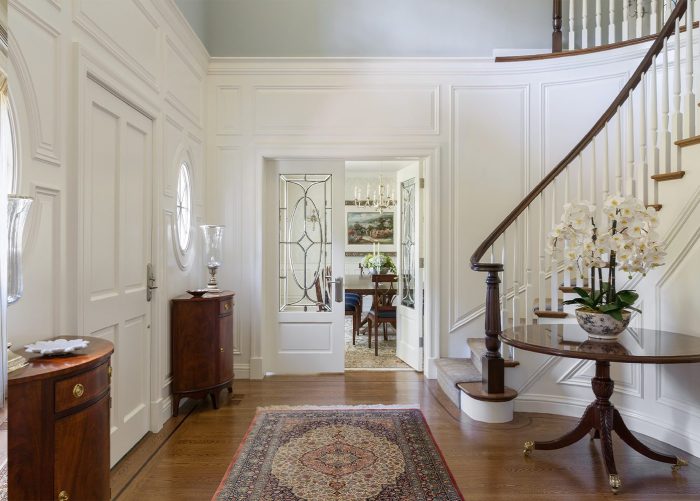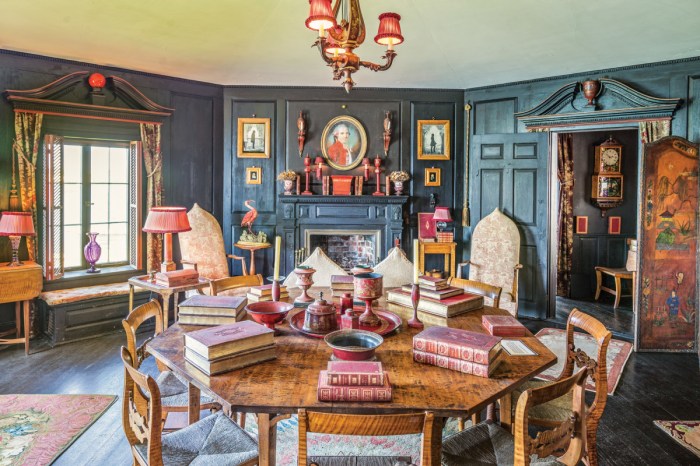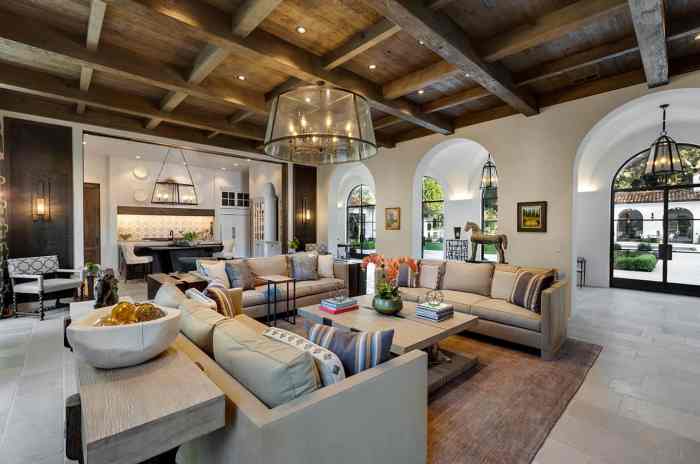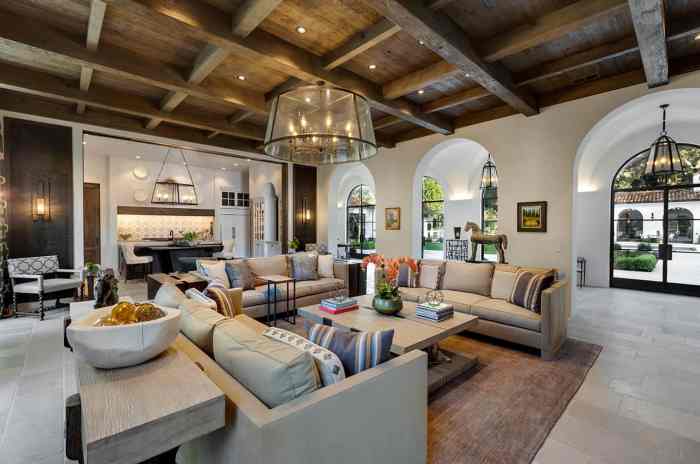Colonial Style House Interior Design: Timeless Elegance
Colonial style house interior design evokes a sense of history and charm, transporting us to a bygone era of elegance and simplicity. From the humble beginnings of early American settlements to the grand estates of the colonial period, this architectural style has left an enduring legacy on interior design, characterized by its classic lines, warm color palettes, and handcrafted details.
This guide delves into the captivating world of colonial style house interior design, exploring its origins, defining features, and enduring appeal. We will uncover the secrets behind its timeless elegance, from the architectural elements and furniture styles to the decorative accents and room-by-room design principles that make it so distinctive.
Creating a Colonial Atmosphere

Bringing the charm and elegance of colonial style into your modern home is a delightful way to infuse history and sophistication into your living spaces. This design aesthetic, characterized by its simplicity, functionality, and timeless appeal, offers a sense of warmth and welcoming hospitality.
Achieving a Colonial Aesthetic
Creating a colonial atmosphere in a modern home involves incorporating elements that evoke the spirit of the past while adapting them to contemporary living. To achieve this, consider the following tips:
- Embrace Warm Color Palettes:Colonial style often features warm, earthy tones that create a cozy and inviting atmosphere. Think rich browns, deep reds, soft creams, and muted blues. These colors can be used on walls, furniture, and accessories to create a sense of depth and warmth.
- Utilize Natural Materials:Colonial interiors embraced natural materials like wood, stone, and leather. Incorporate these elements into your design through furniture, flooring, and decorative accents. Hardwood floors, exposed beams, and stone fireplaces are classic features that contribute to the authentic colonial feel.
- Incorporate Traditional Furniture:Colonial furniture is known for its sturdy construction, simple lines, and practical design. Look for pieces with classic silhouettes, such as wingback chairs, four-poster beds, and antique chests.
- Embrace Simple Elegance:Colonial style prioritizes functionality and simplicity. Avoid excessive clutter and opt for clean lines and understated elegance in your furnishings and décor.
- Layer Textures and Patterns:Add depth and visual interest to your colonial-inspired space by layering textures and patterns. Consider incorporating linen fabrics, woven rugs, and patterned wallpaper.
Colonial Mood Board
A colonial mood board would showcase a harmonious blend of colors, textures, and patterns that evoke the essence of the style. Imagine a palette of rich browns, deep greens, and creams, complemented by the textures of woven wool rugs, distressed wood furniture, and the delicate floral patterns of antique fabrics.
- Colors:Deep greens, rich browns, creamy whites, soft blues, and accents of warm reds.
- Textures:Woven wool rugs, distressed wood furniture, linen fabrics, leather accents, and antique brass hardware.
- Patterns:Floral prints, paisley patterns, and geometric designs in muted tones.
Incorporating Vintage and Antique Elements
Adding vintage and antique elements is a key way to infuse your space with authentic colonial charm. These pieces not only add visual interest but also tell a story of the past.
- Antique Furniture:Look for vintage chairs, tables, or chests with intricate carvings, patinaed finishes, and classic silhouettes. These pieces can serve as focal points in your space, adding a touch of history and character.
- Vintage Fabrics:Incorporate antique textiles into your décor through upholstery, curtains, or throw pillows. Look for fabrics with faded floral patterns, intricate embroidery, or handwoven textures.
- Antique Artwork:Frame vintage prints, maps, or botanical illustrations to create a gallery wall or add character to a blank space. These pieces can add a sense of history and visual interest to your colonial-inspired interior.
- Antique Lighting:Consider incorporating vintage chandeliers, sconces, or table lamps to add a touch of old-world elegance. Look for pieces with crystal accents, brass finishes, or classic designs.
Case Studies of Colonial Style Interiors
The Colonial style is a timeless and elegant design aesthetic that evokes a sense of history, tradition, and sophistication. Exploring real-life examples of Colonial style homes provides valuable insights into the design principles and key features that define this architectural style.
These case studies showcase the versatility of the Colonial style, demonstrating its adaptability to various locations and modern interpretations.
Examples of Colonial Style Interiors
Examining these real-life examples allows us to understand how the Colonial style is implemented in different contexts, showcasing its adaptability and enduring appeal.
- The Mount Vernon Estate, Virginia, USA:This historic home, once owned by George Washington, is a quintessential example of Georgian Colonial architecture. The interior features intricate woodwork, fireplaces, and elegant furnishings, reflecting the refined tastes of the 18th century. The rooms are characterized by symmetry and balance, with a focus on functionality and comfort.
- The Longfellow House, Cambridge, Massachusetts, USA:This 18th-century home, once inhabited by poet Henry Wadsworth Longfellow, exemplifies the Federal Colonial style. Its interior features delicate details, such as decorative moldings, intricate fireplaces, and elegant furniture. The rooms are designed to be both grand and inviting, reflecting the intellectual and cultural pursuits of the time.
- The Hammond-Harwood House, Annapolis, Maryland, USA:This 18th-century mansion is a prime example of the Georgian Colonial style. The interior features a grand staircase, intricate plasterwork, and a collection of period furniture. The rooms are characterized by a sense of formality and grandeur, reflecting the wealth and status of the original owners.
Key Design Features of Colonial Style Interiors
The Colonial style is characterized by a distinct set of design features that create a cohesive and timeless aesthetic.
- Woodwork:Colonial style interiors often feature extensive use of wood, both in the construction and decorative elements. This includes wainscoting, paneling, and intricate moldings, adding warmth and character to the space.
- Fireplaces:Fireplaces are a central feature in many Colonial style homes, providing both warmth and ambiance. They are often adorned with elaborate mantels, reflecting the craftsmanship of the era.
- Furniture:Colonial style furniture is known for its simplicity, functionality, and craftsmanship. Key pieces include sturdy chairs, tables, and beds made from solid wood, often with intricate carvings or details.
- Color Palette:The color palette of Colonial style interiors typically features muted and earthy tones, such as creams, browns, greens, and blues. These colors create a sense of tranquility and sophistication, reflecting the natural world and the era’s preference for simplicity.
- Lighting:Colonial style homes often feature a combination of natural and artificial light. Large windows allow ample sunlight to flood the rooms, while chandeliers, sconces, and lanterns provide a warm and inviting ambiance.
Table of Case Studies
This table summarizes the key features of the Colonial style interiors discussed above, highlighting the diverse interpretations and variations within this design aesthetic.
| Home | Location | Architectural Style | Key Design Features |
|---|---|---|---|
| Mount Vernon Estate | Virginia, USA | Georgian Colonial | Intricate woodwork, fireplaces, elegant furnishings, symmetry and balance |
| Longfellow House | Cambridge, Massachusetts, USA | Federal Colonial | Decorative moldings, intricate fireplaces, elegant furniture, grand and inviting rooms |
| Hammond-Harwood House | Annapolis, Maryland, USA | Georgian Colonial | Grand staircase, intricate plasterwork, period furniture, formality and grandeur |
DIY Projects for Colonial Style Interiors

Embracing a colonial style doesn’t require breaking the bank. You can achieve the desired ambiance by incorporating DIY projects that blend functionality with historical charm. These projects not only add a personal touch to your home but also offer a sense of accomplishment and a unique way to express your creativity.
Creating Colonial-Inspired Furniture, Colonial style house interior design
Transforming existing furniture pieces or building new ones from scratch can significantly impact the colonial aesthetic of your home. You can use a variety of techniques to achieve the desired look, from distressing wood to incorporating traditional joinery methods.
- Repurposing Old Furniture:An old dresser can be given a new lease on life by stripping off its existing paint, sanding it down, and applying a fresh coat of colonial-inspired paint. Consider using chalk paint, which creates a vintage look and adds a layer of character.
Alternatively, you can stain the wood to bring out its natural grain and give it a warm, aged feel.
- Building a Colonial-Style Coffee Table:You can use reclaimed wood, salvaged from old barns or furniture, to construct a sturdy coffee table. This approach aligns with the colonial spirit of repurposing and using readily available materials. You can use simple joinery techniques like mortise and tenon joints to create a table with a rustic charm.
- Creating a Colonial-Style Bench:A simple bench can be built using basic woodworking skills and readily available materials. You can use pine or oak for the frame and seat. To add a colonial touch, consider adding turned legs or a simple carved detail to the backrest.
Restoring and Repurposing Antique Furniture
Antique furniture pieces often carry a rich history and can be a valuable addition to a colonial-style interior. However, restoring and repurposing these pieces requires patience and a careful approach.
“Respect the history of the piece and avoid removing its original patina or character.”
- Assessing the Furniture:The first step is to assess the furniture’s condition. Identify any areas that need repair, such as broken legs, loose joints, or damaged veneer. You may need to consult a professional for more complex repairs.
- Cleaning and Refinishing:Once the furniture is repaired, it’s time to clean and refinish it. You can use a mild detergent and water to clean the surface. For refinishing, you can choose to strip the old finish and apply a new one, or you can simply apply a coat of wax to enhance the existing patina.
- Repurposing Antique Pieces:An antique dresser can be repurposed into a charming vanity by adding a mirror and a new top. A vintage table can be transformed into a unique coffee table by adding a glass top or a custom-made wooden top.
Crafting Colonial-Style Accessories
Adding handcrafted accessories to your colonial-style home can enhance its charm and personalize the space. You can create lampshades, curtains, or wall art using simple techniques and readily available materials.
- Colonial-Style Lampshades:You can create a simple lampshade using fabric and a wire frame. Choose fabrics with colonial-inspired patterns, such as floral prints or geometric designs. You can add a decorative trim to the bottom of the shade for a finishing touch.
- Colonial-Style Curtains:Curtains can be crafted from cotton or linen fabrics, often in natural colors like cream, white, or beige. You can add a simple border or trim to the top and bottom of the curtains. Consider using a valance to add a touch of elegance.
- Colonial-Style Wall Art:Colonial-style wall art can be created using a variety of techniques. You can create a simple framed print using a vintage map or a botanical illustration. You can also create a decorative wall hanging using fabric scraps, buttons, and beads.
Ending Remarks

Whether you’re seeking to recreate the authentic colonial experience or simply infuse your home with a touch of its timeless charm, this guide provides a comprehensive exploration of colonial style house interior design. From understanding the historical context to mastering the art of incorporating vintage elements and modern interpretations, you’ll discover a wealth of inspiration and practical tips to transform your home into a sanctuary of classic elegance.
Answers to Common Questions: Colonial Style House Interior Design
What are some popular color palettes used in colonial style interiors?
Colonial style interiors often feature warm and earthy tones like cream, beige, sage green, and deep blues. These colors evoke a sense of tranquility and sophistication.
How can I incorporate vintage elements into a colonial-inspired interior?
Consider incorporating antique furniture pieces, vintage textiles, and antique lighting fixtures. These elements add character and authenticity to the space.
What are some key furniture styles associated with colonial design?
Classic colonial furniture styles include Chippendale, Queen Anne, and Federal, known for their elegant lines, craftsmanship, and use of wood like mahogany and cherry.
Are there any modern interpretations of colonial style?
Yes, modern designers often incorporate colonial elements like wainscoting, crown molding, and simple furniture designs into contemporary interiors, creating a fresh and updated look.

